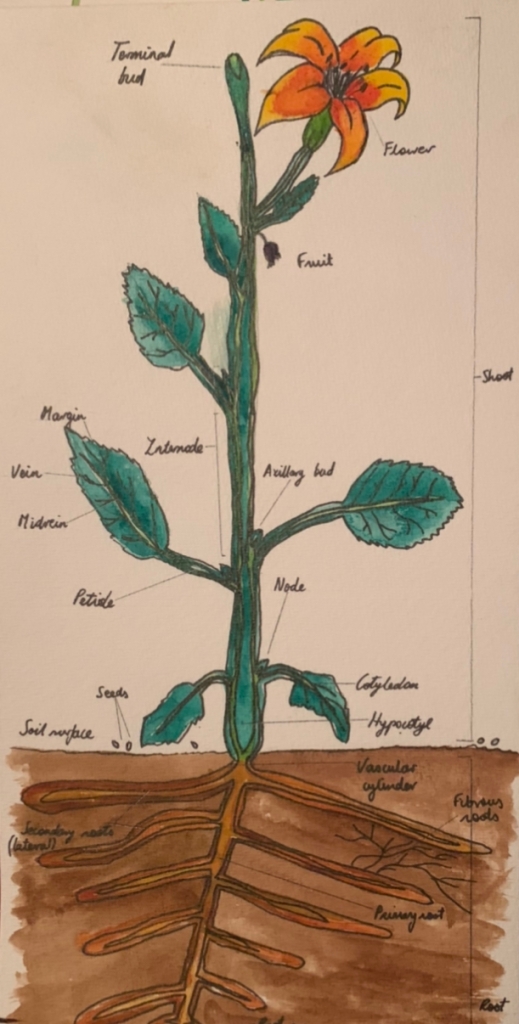It was another day of college today and my laptop decided to fail me, just in time for online learning! Learning is never easy outside of the classroom and not being able to access the documents we’re working on makes it even harder. Still, we covered a lot and I only got slightly left behind!
Here are some of the topics we focused on today:
- Health and Safety Legislation
- Vascular system of a plant’s stem
I’m going to focus on the second topic, for obvious reasons (i.e. posting about legislation an interesting blog does not make). I would argue that the stem of a plant is one of the least appreciated parts of a plant. When looking at a plant’s distinguishing features, you often think of things like the foliage shape and texture, the showy flowers or the berries and fruit. However, the stem is the literal backbone of the plant. It acts as support in adverse weather (with the help of the roots), it transports nutrients around the plant and the stem is one way you can clone your plant to produce a genetically identical replica, for free!
We dived into botany today, looking at plant cells up close and discovering the different processes that happen beneath the surface and just how important they are. To kick off the learning, let’s talk about monocotyledons and dicotyledons:
- Monocotyledon (or monocots): this refers to flowering plants that have scattered vascular bundles in their stems and are characterised by their lack of cambium (see below) between the xylem (also see below) and phloem (just see below for all, please). There is also no distinction between the cortex and pith and no annual rings (tree rings) are formed.
- Dicotyledons (or dicots): unlike monocots, these have a limited number of vascular bundles arranged in a ring. Cambium does exist in dicots and and the cortex and pith are distinguishable. Secondary thickening can occur (I’ll get into this later) and annual rings form as a result of this.
Distinguishing between dicotyledons and monocotyledons is important, as it tells us a lot about what the internal structures are going to look like. The best way to differentiate between a monocot and a dicot is seeing what its first leaves look like. If a pair of kidney bean-shaped leaves appear, that’s a dicot, whereas if one grass-like leaf grows out of the soil, that’s a monocot.
Let’s look at the structure of a stem. Most dicots have a similar structure to this and may only show slight variation or modified bits and pieces. Here’s a diagram I put together at the beginning of the year:

Terminal (or apical) bud: this is the topmost bud and the one responsible for terminal growth. Due to the auxin hormone, most of the energy goes into growth from this terminal bud and growth is inhibited in the lateral buds. This is why gardeners ‘pinch out’ plants that they want to grow bushier or to put on more lateral growth – the energy stops being solely directed to the terminal bud and lateral buds get a chance to grow.
Lateral (or axillary) bud: These are the aforementioned buds that are further down the stems. They are produced in the leaf axils and are responsible for the lateral shoots from the main stem.
Flower bud: These develop into flowers and are often larger in size than the buds that produce vegetative growth.
Leaf scar: This is the scar from from the place where a leaf was joined onto the stem. It is also called the abscission scar.
Node: This is the point on the stem where a leaf used to be. The angle between the petiole (leaf stalk) and the stem is known as the leaf axil.
Internode: This is the length along the stem between two nodes.
(Not mentioned in the diagram:)
Lenticel: These are pores in the stem through which gasses may be exchanged. The relative size and shape of the lenticels can be a distinguishable feature when identifying plants.
Growth rings: This is sometimes called the girdle scar and indicates where the growth stopped after the end of the growth period the year prior. Therefore the length of the stem between two girdle scars or the terminal bud and the previous girdle scar will advise how much the plant grew the previous growing season.
And now, let’s look even closer – with a microscope! Inside any plant’s stem, there are three main players: the xylem, the phloem and the cambium. These form the vascular system of the plants, transporting food, water and minerals around the plant and offers support.
Vascular cambium (F): this is known as a meristem, meaning it is made up of undifferentiated cells and is capable of cell division. These cells have the ability to develop into any of the other tissues and organs in the plant. It is located between the xylem and the phloem inside the bark of the stem. Its cell division and growth make it responsible for increasing the girth of a stem.
Xylem (D): this conducts water and dissolves minerals and nutrients upwards from the roots to all the other parts of the plant. The xylem vessels’ walls are thickened with secondary deposits of cellulose and this causes secondary thickening. In older plants, the xylem stops helping with transporting water and nutrients and serves to give support to the growing trunk. As such, wood is xylem and when counting the annual rings of the tree, you are counting the rings of xylem.
Phloem (located under the bundle cap – E): this is produced towards the outside of stem on the other side of the cambium. Phloem transports the glucose produced through photosynthesis in the leaves and around the rest of the plant.

Jon Houseman / CC BY-SA (https://creativecommons.org/licenses/by-sa/4.0)
Secondary thickening can happen in all dicots, however, it is more noticeable in perennials and woody dicots. Secondary thickening refers to the thickening of the stem as a result of the primary xylem and primary phloem being moved further and further apart. Annual rings will develop as a result of this and appear as alternating rings of spring and autumn wood.
There’s a lot more we can get into around this topic, however, I think modified stems a little more attention grabbing. While typical stems occur above ground and feature all the different parts listed above, modified stems can exist above and below ground and serve many more purposes than you might think.
Chlorophytum comosum variegatum (Spider Plant) produces plantlets, which are young plants that arise from modified flowering stems. These can also be called stolons.
Sempervivum tectorum (Common Houseleek) dsplay offsets, which are young plants produced from the base of the rosette forming new plants.
A crown is an area of compressed stem tissue. This is where new shoots are produced, generally found near the surface of the soil. Taraxacum officinale (dandelion) are compressed stems which produce leaves and flowers on short internodes. Runners are a kind of stolon, produced from the crown, from which new plants will grow.
Stolons are horizontal stems that are fleshy or semi-woody and lie along the ground. Stolons are specialised stems that run across the soil surface and create a new plant at one of more of its nodes. Strawberries are good examples of this!
Stolons are often confused with rhizomes, which are a different kind of specialised stem which grows horizontally just below the soil surface. They act as a storage organ and a means of propagation for some species. Some rhizomes, such as in irises, are compressed and fleshy.
Spurs are compressed fruiting branches, common on fruit trees such as Pyrus spp. (Pear trees), where they bear fruit.
Tubers are enlarged portions of an underground stem, such as potato tubers. Like any other stem, a tuber has nodes that produce buds. These are the eyes of a potato and contain clusters of buds. It is important to note that root tubers also exist.
Corms are solid, swollen stems. They are different to bulbs in that they do not contain fleshy scales. Instead, they have been reduced to a dry, leaf-like covering. New corms are formed on top of older, exhausted ones, meaning that adventitious roots develop to sink it to the correct depth.
Unlike corms, bulbs have fleshy scales and produce shortened, compressed, underground stems. The scales envelop a central bud located at the tip of the stem.
So there’s a mammoth amount of information about stems! Stems are one of the most important parts of the plant and I always see it as the HQ of the plant, sending nutrients where they’re needed and offering support. I can’t wait to do some stem cuttings at college next week so I can put all this theory into practice!
